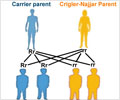Researchers have identified that a genetic mutation that occurs before the birth of a child is responsible for Sturge-Weber syndrome (SWS).

"This is a complete game changer for those with Sturge-Weber syndrome and the millions born with port-wine birthmarks," said co-senior study author, Anne Comi, M.D., Director of the Kennedy Krieger Institute's Hunter Nelson Sturge-Weber Center. "Now that we know the underlying genetic mutation responsible for both conditions, we're hopeful that we can move quickly towards targeted therapies, offering families the promise of new treatments for the first time."
Sturge-Weber syndrome is a neurological and skin disorder associated with port-wine birthmarks on the face, glaucoma, seizures, intellectual impairment and weakness on one or both sides of the body. Current treatment options for children with SWS are limited, but include medications to reduce the likelihood of seizures and stroke-like episodes, eye drops and/or surgery to manage glaucoma, and physical rehabilitation.
Port-wine stain birthmarks are caused by abnormally dilated capillaries in the skin, which produce reddish to purplish discoloration. While a facial port-wine birthmark can be associated with SWS, they occur commonly in otherwise healthy individuals. Physicians may perform several painful laser treatments to attempt to remove the port-wine birthmark in infant children, but it often reoccurs.
"This study presents a turning point for research on Sturge-Weber syndrome and port-wine birthmarks," said Jonathan Pevsner, Ph.D., Director of Bioinformatics at Kennedy Krieger Institute and co-senior study author. "While we suspected that a somatic mutation was the cause for decades now, the technology to test the theory didn't exist. The advancements in whole genome sequencing and the development of next-generation sequencing tools finally allowed my lab to test and prove the hypothesis."
Dr. Pevsner's laboratory found the somatic mutation (a change in DNA that occurs after conception and affects only part of the body) that causes SWS and port-wine birthmarks by performing whole genome sequencing on affected and unaffected tissue and blood samples from three individuals with SWS. They were able to identify one somatic mutation shared by all three affected samples – a nucleotide transition in gene GNAQ on chromosome 9q21. In a separate analysis, the researchers confirmed the finding by detecting the mutation in 23 out of 26 tissue samples from subjects with SWS and 12 out of 13 samples from subjects with isolated port-wine birthmarks. The control samples, and most of the unaffected samples, did not possess the mutation. These analyses also revealed the surprising outcome that the gene involved in SWS is the same gene implicated in uveal melanoma, a type of melanoma that occurs in the eye.
Advertisement
With the discovery of the gene and pathway involved in SWS and port-wine stains, researchers can now begin investigating drugs that selectively inhibit the implicated pathways. The link to melanoma may also influence research and lead to new directions for the treatment of both conditions in the future.
Advertisement
In revealing that SWS is caused by a somatic mutation, researchers have also confirmed for the first time that Sturge-Weber is not an inherited syndrome – a meaningful insight for many parents. "When a child receives a diagnosis of Sturge-Weber, parents are often filled with questions about whether they passed down the condition to their child," said Dr. Comi. "We can now definitively put those fears to rest."
Source-Eurekalert














